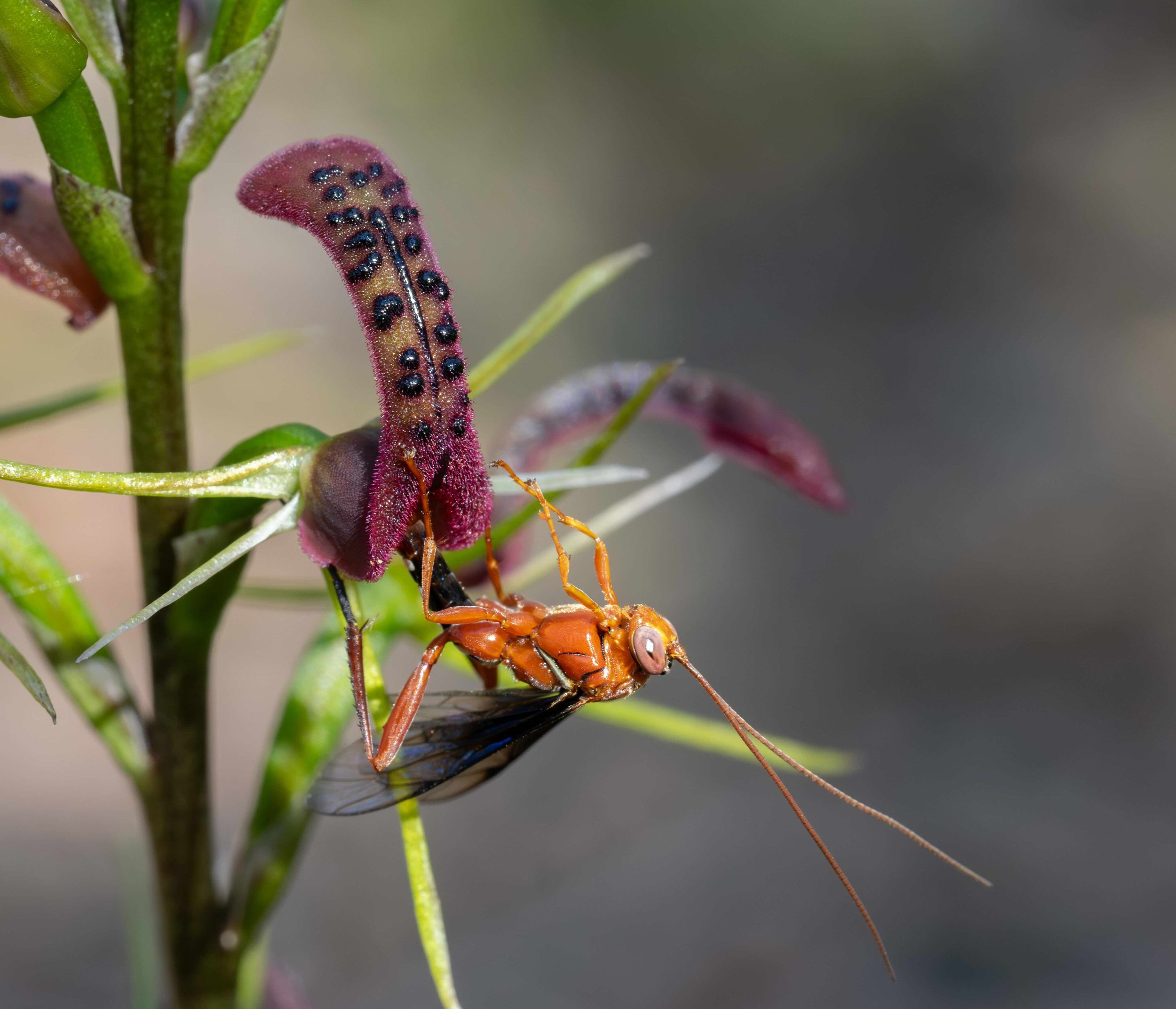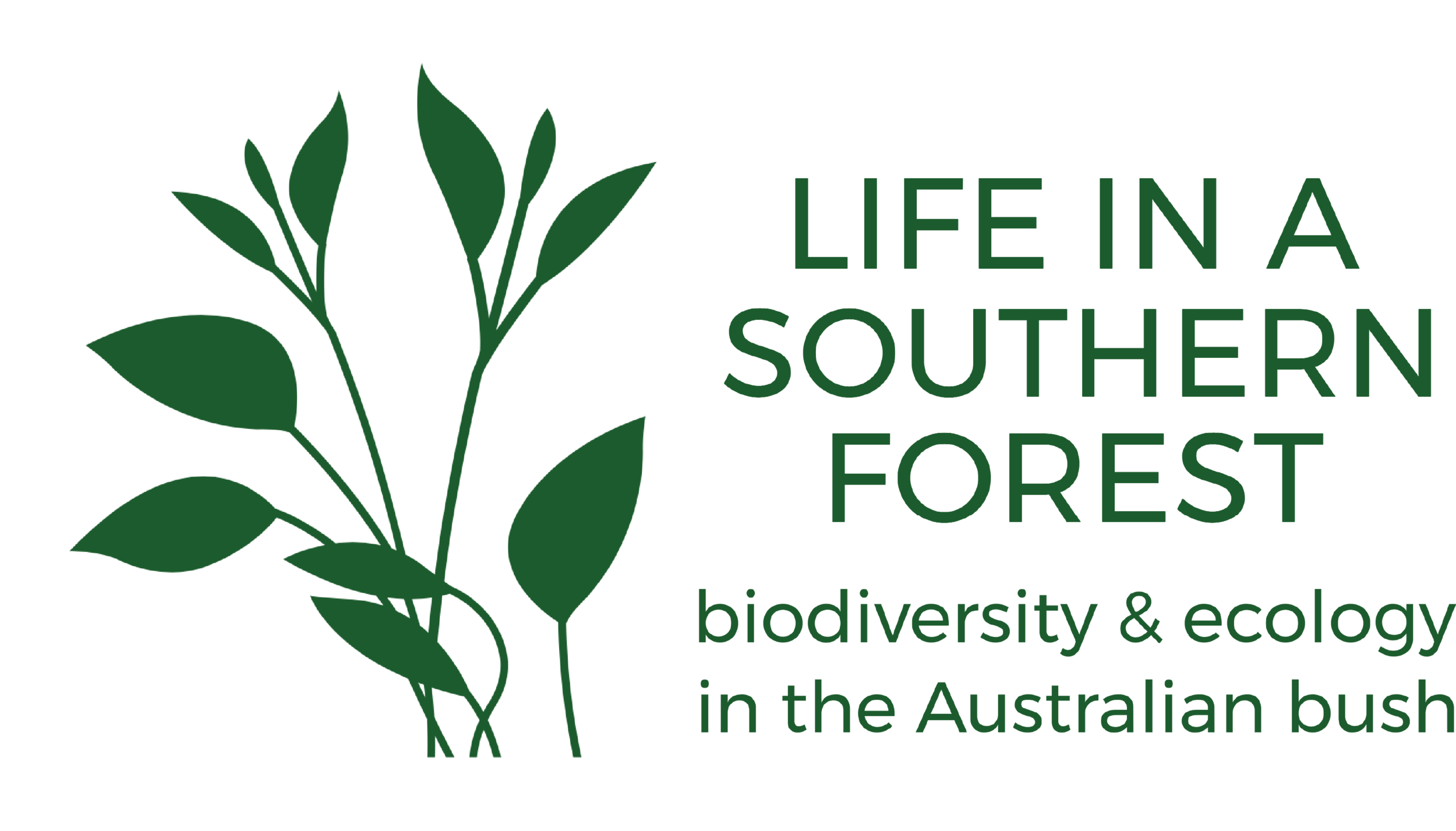Unfolding floral drama

Four years ago, in the first spring after the January 2020 fire, we were fortunate to witness a pair of coincident special events - the blooming of the Small Tongue-Orchid (Cryptostylis leptochila) and its relationship with the male Orchid Dupe Wasp (Lissopimpla excelsa).
An orchid designed for a wasp
The Small Tongue-Orchid begins flowering in a conventional way, sending a stem upwards from the soil in early spring. A cluster of flower buds soon forms at its tip and as the stem advances, single buds are left at regular intervals along its length. These buds open sequentially from the bottom to the top of the stem.
The next phase, unfurling of the buds, is when the drama occurs. The labellum is revealed. A tongue-shaped, purplish-red highly modified petal with short bristles and rows of black blobs. It is held in an upright position for two days before collapsing forwards. While erect, it plays a key role in the reproduction of the orchid because of its attraction for the other player, the wasp.
As I recounted in my 2020 blog post, the Orchid Dupe Wasp is fooled (duped!) into thinking the labellum is his female partner and attempts to copulate with it. The video above from 2020 shows the wasp in action (with some competition from another male).
The male’s exertions serve the orchid’s ends. A cohesive mass of pollen (a pollinia) sticks to the tip of his abdomen during this pseudo-copulation.
When he moves to a second orchid to repeat the act, he efficiently (if inadvertently) pollinates it with the pollinia from the first.
While the wasp’s behaviour assists reproduction of the orchid, it does nothing to help him reproduce. He gains nothing. He is wasting time better spent seeking a genuine female instead of this gaudy facsimile.
The orchid flowers again
I’ve had to wait four years for a reprise.
Like many orchids, the Small Tongue-Orchid is a capricious bloomer. This is the same plant that flowered in 2020 and it hasn’t bloomed again since then. Furthermore, we’ve only ever found this one plant in our home forest. I’ve had to be patient.
17th December 2024
This spring, it performed again, producing an inflorescence with an array of around 15 flower buds.
By mid December, opening of those buds was well underway, as shown in this photo.
The lowest 3 buds had opened a few days previously and their labellum has collapsed.
The next two have only recently opened and bear their labellum erect in a wasp-ready configuration.
One of that pair was the first flower of this plant I had seen since 2020.
I photographed it as soon as I noticed it.
The wasp returns!
I’d no sooner got a shot of that first flower, when it was photo-bombed.
Just 10 minutes later, who should appear!
The orchid was doing its trick very nicely thank you.
The wasp, or rather wasps, as there is certainly more than one in our forest, was a regular visitor to this and other flowers on the following days.
In the photo below, taken 12 days later, a male can be seen busily pseudo-copulating with a flower.
Then, just 3 minutes later, he has swapped to the opposite flower.
The video below reveals that he is carrying a pollinia on the end of his abdomen. He may have picked this up when he was grappling with the other flower.
Teasing apart the dynamics of blooming
During my observation of this plant back in 2020, I established that unfurling of each bud took less than a day. This time I chose to determine the exact sequence and timing of this process.
There are 6 main components in each orchid flower - 3 sepals and 3 petals, one of the latter being highly modified to form the labellum.
These bits are packed tightly together in the closed bud.
In what order do these parts open and how long does it take for each to get to its final position?
The only way to answer these questions was to watch a single bud from the first sign of opening to the fully opened flower, taking photos at regular intervals. I wasn’t sure how regular, but I chose every 3 minutes to make sure I didn’t miss anything.
It was clear that this would take the best part of a day of continuous observation.
I made myself comfortable in a camp chair in the middle of the forest with my camera on a tripod aimed at our orchid
The camera was focussed on the next unopened bud and set to automatically take a photo every 3 minutes - with flash when inevitably it got dark
I had no idea when that next bud would start to open.
Somehow or other I managed to choose 25th December for this task. As it turned out action got underway at around 10:00 am.
Having done the maths, I realised this was going to be an all nighter.
Too bad about Christmas Dinner.
First phase: 10:00 am – 4:47 pm
This time-lapse movie shows the first phase of flower opening. Each frame of the movie is separated from the next by 3 minutes. (Drag the slider in the time bar below the video to move to an earlier or later time point. You can change the speed of the movie by clicking on the settings icon in the bottom right hand corner of the screen).
The right lateral sepal separates first, then 20 minutes later, the left lateral sepal, the ventral sepal and the left and right petals separate together. They all continue to move further apart over the next 4 hours.
Over the same period the labellum bends in the middle with its tip dipping downwards.
Second phase: 4:50 pm – 7:56 pm
In this phase, the labellum gradually lifts upwards until its tip lies at the same level as its base. The petals and sepals move a little further apart.
Final phase: 8:00 pm – 2:00 am
In this dramatic final phase, the labellum lifts upwards to a fully erect position. It was a rare treat to witness this action while sitting alone in the middle of the forest in the dead of night.
So the orchid is now all set for the entry of the wasp from stage left.




